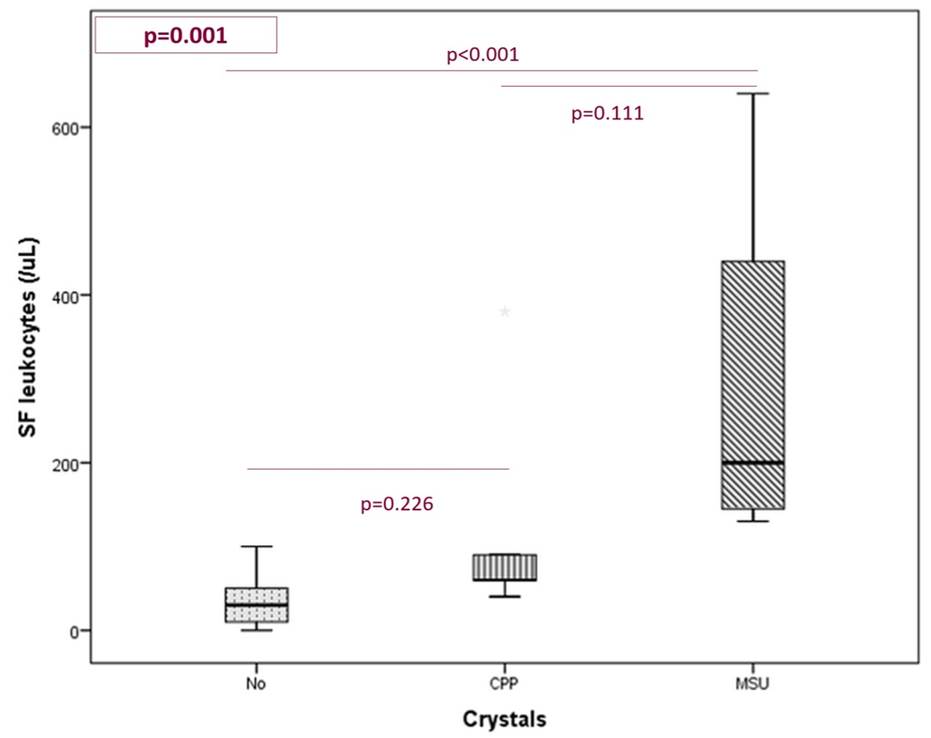Session Information
Session Type: ACR Poster Session C
Session Time: 9:00AM-11:00AM
Background/Purpose: Articular and periarticular deposits of monosodium urate (MSU) crystals in asymptomatic hyperuricemia (AH) may associate with more severe forms of atherosclerosis [Andrés 2016]. This likely relates with crystal-driven subclinical inflammation, a phenomenon well described in gout [2] but to date not assessed in AH. The aim of the present study was to assess the synovial fluid (SF) leukocytes count in patients with AH depending on the presence of crystals.
Methods: Consecutive patients with AH were selected from nephrology clinics. Hyperuricemia threshold was established at serum uric acid (SUA) >=7mg/dL; those on current urate-lowering therapy were excluded. Ultrasound (US) of knees, ankles and first metatarsophalangeal joints was performed blinded to clinical and laboratory data, to perform US-guided aspiration and obtain SF samples. Samples were jointly analyzed in fresh by two observers, using a compensated polarized light microscope equipped with two viewing stations. The second observer was also unaware of US findings. The presence of leukocytes and crystals was established by consensus. SF leukocyte count was performed using a Neubauer counting camera. Mann-Whitney’s U and Kruskal-Wallis’ H were used for comparisons between groups.
Results: A total of 30 patients have been assessed, with SF samples available from 27 (three showed no joint effusion at US). Median age was 70 years (p25-75 59.8-75.5), and 16 of them (60%) were males. Median (p25-75) SUA and estimated glomerular filtration rate were 8.1 mg/dL (7.6-8.5) and 37.0 mL/min (31.0-47.5), respectively. Seven (25%) were on diuretics. After microscopy evaluation, MSU crystals were found in four patients (14.8%), calcium pyrophosphate (CPP) crystals in five (18.5%), and no crystals in 18 (66.7%). Groups were similar in SUA levels and renal function. Figure shows median leukocytes count according to crystal group: 200/mm3 (138-540) in MSU group; 60/mm3 (50-235) in CPP group; and 30/mm3 (10-53) in those with no crystal at SF. A statistically significant difference was found between the three groups (p=0.001), and comparing MSU crystals and no crystals groups (p<0.001); no difference was found between MSU and CPP groups, nor between CPP and no crystals groups.
Conclusion: MSU crystal deposition in patients with AH leads to higher SF leukocyte count, indicating low-grade inflammation. Despite low numbers, this significant finding adds evidence to the potential deleterious role of silent crystal deposits in AH patients.
To cite this abstract in AMA style:
Andrés M, Bernal JA, Arenas MD, Pascual E. Synovial Fluid Leukocyte Count and Its Association with Crystal Deposition in Asymptomatic Hyperuricemia [abstract]. Arthritis Rheumatol. 2017; 69 (suppl 10). https://acrabstracts.org/abstract/synovial-fluid-leukocyte-count-and-its-association-with-crystal-deposition-in-asymptomatic-hyperuricemia/. Accessed .« Back to 2017 ACR/ARHP Annual Meeting
ACR Meeting Abstracts - https://acrabstracts.org/abstract/synovial-fluid-leukocyte-count-and-its-association-with-crystal-deposition-in-asymptomatic-hyperuricemia/

